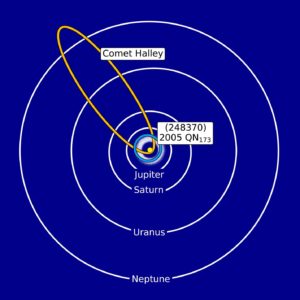
A team of scientists including Lowell Observatory’s Dr. Audrey Thirouin have characterized a rare solar system body that exhibits characteristics of both comets and asteroids. Of the half-million known members of the asteroid belt, this is only the eighth that is not only active like a comet, but has been so on multiple occasions.
Scientists discovered asteroid (248370) 2005 QN137 in 2005. It became of special interest on July 7, 2021, when observations by the Asteroid Terrestrial-Impact Last Alert System (ATLAS) survey revealed a tail, indicating activity like that of a comet.
Astronomers believe this activity may involve icy material sublimating and have designated the object a main-belt comet. This is a type of solar system body that has displayed cometary activity on at least one occasion but is otherwise similar to other main belt asteroids. To date, only about 20 such objects have been identified.
The team’s lead researcher, Dr. Henry Hsieh of the Planetary Science Institute in Tucson, spoke about the study at the 53rd Annual Meeting of the American Astronomical Society’s Division for Planetary Sciences. In an associated press release, Hsieh said “248370 can be thought of as both an asteroid and a comet, or more specifically, a main-belt asteroid that has just recently been recognized to also be a comet. It fits the physical definitions of a comet, in that it is likely icy and is ejecting dust into space, even though it also has the orbit of an asteroid.”

The object’s main body measures about one mile in diameter. The tail observed in July stretched more than 450,000 miles long but only 900 miles wide. Hsieh said, “This extremely narrow tail tells us that dust particles are barely floating off of the nucleus at extremely slow speeds and that the flow of gas escaping from the comet that normally lifts dust off into space from a comet is extremely weak. Such slow speeds would normally make it difficult for dust to escape from the gravity of the nucleus itself, so this suggests that something else might be helping the dust to escape.”
Comets are icy objects generally found in the outer solar system. They can form tails if they move toward the inner part of the solar system. Warmth from the Sun sublimates the ices into gas, which with associated dust that is released from the ice creates a tail. Main-belt asteroids, on the other hand, are located in the warmer, inner part of the solar system—between Mars and Jupiter—and likely lost any icy material long ago.
Hsieh said, “This duality and blurring of the boundary between what were previously thought to be two completely separate types of objects – asteroids and comets – is a key part of what makes these objects so interesting.”
Several telescopes were used in the research, including the Lowell Discovery Telescope. Owned and operated by Lowell Observatory, it was used to obtain follow-up observations of 248370 that confirmed its comet-like activity.